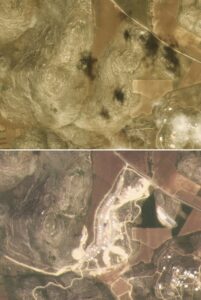- 259
- 267SHARES

This AP photo by Maya Alleruzzo carries a caption alleging: “Israel went on an aggressive settlement spree during the Trump era”
In 2016, during the last year of the Obama administration, there were 3,276 settler housing starts. It was the highest such number since the year 2000, when there were 4,965 housing starts.
The annual number of housing starts under the Trump administration has not hit that same height, with 1,733 starts in 2017, 2,376 starts in 2018 and 1,548 starts in 2019.
Those who value the settlement enterprise might also be disheartened by recent data. In 2010, the annual growth rate of the Jewish population in the West Bank was 5 percent, thanks to the addition of nearly 16,000 new residents each year. But the uptick has tapered off steadily since then, to a nadir of 2.6 percent last year – slightly more than 12,000 newcomers. And nearly 11,000 of them were babies, most of them born not in the scattered hilltop locales but in the Haredi cities of Betar Ilit and Modi’in Ilit. Apparently relatively few new people are choosing this way of life, or perhaps the number of newcomers is being offset by the number of leavers.
Thus, in its most recent report on settlements, U.N.’s High Commission for Human Rights wrote Feb. 15, 2021:
The official data available for the period from 1 November 2019 to 31 September 2020 indicate a decrease in the commencement of new settlement construction in Area C (837 units compared with 1,504 during the previous period).
The official data available for the period from 1 November 2019 to 31 September 2020 indicate a decrease in the commencement of new settlement construction in Area C (837 units compared with 1,504 during the previous period).
Similarly, UNHCHR’s Jan. 30, 2019 report, which covers Nov. 1, 2017 to Oct. 31, 2018, found: “During the period under review, planning for settlements continued, while the actual commencement of construction decreased. . . .” Footnote 6 specified: “Footnote 6: Data are available only for the period 1 November 2017–1 October 2018 (1,659 units) and 1 November 2016–1 October 2017 (2,269 units).”
Significantly, UNHCHR’s March 6, 2018 report on settlement activity, which covers Nov. 1 2016 to Oct. 31, 2017, the end of the Obama administration and the first nine or so months of the Trump administration, found:
During the period under review, a sharp increase in settlement planning was witnessed, despite a slowdown in the actual commencement of new construction . . .
According to data obtained from the Israeli Bureau of Statistics, the rate of construction starts in Area C settlements witnessed a decline of more than 50 per cent during the first three quarters of 2017 (1,120 units in nine months) as against 2016 (3,027 units in 12 months).

This image accompanies AP’s report. The caption states: “This combination of satellite images provided by Planet Labs Inc. shows the growth of the West Bank Jewish settlement of Amichai, with photos of March 5, 2017, top, and March 16, 2021. The satellite images and data obtained by the AP document for the first time the full impact of the pro-settlement policies of then-President Donald Trump. (Planet Labs Inc. via AP)” Despite Trump’s purported pro-settlement policies, Amichai was the only new settlement established in his tenure, and in decades.
But AP’s “investigation” does not at all examine or address official Israeli data. Nor does AP disclose to its readers that the source of its satellite images and all of its data is apparently the anti-settlement watch group Peace Now, whose figures are identical to all of those that AP cites. Indeed, AP’s article reflects an uncritical rehashing of Peace Now data, not an independent investigation of the subject, which would have taken the Peace Now information into account, alongside data from the Central Bureau of Statistics.
As former AP reporter Matti Friedman noted about the work of his former colleagues: “Nearly all of the information you need—that is, in most cases, information critical of Israel—is not only easily accessible but has already been reported for you by Israeli journalists or compiled by NGOs.”
CBS Vs. Peace Now Data
An independent investigation would have uncovered a vast discrepancy between Peace Now and official government data, but AP’s story ignores this key information.
For instance, AP reports: “According to Peace Now, an anti-settlement watch group, Israel built over 9,200 new homes in the West Bank presidency during the Trump presidency.” Peace Now’s figures for construction starts of residences in West Bank settlements during the Trump years are as follows: 2,783 units in 2017; 2,100 units in 2018; 1,917 units in 2019, and 2,433 units in 2020 (sources: Peace Now’s 2019 and 2020 reports), a total of 9,233 units for which construction began under the Trump era.
In contrast, according to Israel’s Central Bureau of Statistics, the number of construction starts during the Trump years are as follows: 1,731 units in 2017; 2,397 units in 2018; 1610 units in 2019; and 1026 units in 2020, for a total of 6,764 units — significantly less than the 9,233 cited by Peace Now. (The CBS figure is substantially lower than Peace Now’s even though the former source takes all of 2020 into account, and the later only had data for half of 2020, as it conducts its yearly count from mid-year to mid-year.)
(It should also be noted that Peace Now’s data addresses only construction starts, not completed construction, and therefore the statement that “According to Peace Now, an anti-settlement watchdog group, Israel built over 9,200 new homes in the West Bank during the Trump presidency” is misleading. More accurate wording is: “According to Peace Now, an anti-settlement watchdog group, construction began on more than 9,200 new homes . . .”
Moreover, CBS data on the number of homes completed during this period is also significantly less than 9200, as it totals 7577 units.)
The differences in the CBS versus Peace Now data on construction starts have a significant impact on the crux of the Peace Now/AP thesis: that settlement growth enjoyed a huge spike under the Trump era.
Annual Averages of Construction Starts: Incline or Decline?
Of the reported 9200 units constructed during Trump’s years, AP reported that according to Peace Now: “On an annual average, that was roughly a 28% increase over the level of construction during the Obama administration, which pressed Israel to rein in building.”
But CBS data paints a diametrically opposed picture, in which construction starts decreased in Trump’s time compared to Obama’s. According to CBS data, there were 6764 constructions starts in Trump’s four years, yielding a 1691 yearly average. Also, according to CBS data, there were 14,722 construction starts in Obama’s eight years, for an annual average of 1840 starts. (CAMERA’s data is from the Statistical Abstracts of Israel 2012-2017, plus the Table 3 linked above and from the 2020 report for 2015 and 2016 data. In the case of minor discrepancies between two CBS documents, CAMERA relied on the more current material.)
Settler advocates have repeatedly said that it would take several years for Trump’s support to manifest in actual construction. Peace Now said that trend is now in its early stages and expected to gain steam.
“2020 was really the first year where everything that was being built was more or less because of what was approved at the beginning of the Trump presidency,” said Peace Now spokesman Brian Reeves. “It’s the settlement approvals that are actually more important than construction.”
Also, in paragraph 12, AP’s Krauss reasonably points out: “It usually takes one to three years for construction to begin after a project has been approved.” If that’s the case, and it’s also the case that Trump’s supportive policies have enabled massive settlement construction compared to those of its predecessor, AP fails to explain why, according to both Israel’s CBS and UNHCHR, there were far more building starts in the last year of Trump’s term compared to the last year of Obama’s term.
In 2020, four years into Trump’s term, once his administration’s allegedly permissive policy enabled mass numbers of plans to mature to the building stage, the construction starts totaled only 1,026 units (according to CBS data) or 837 units (according to UNHCHR data). In 2016, the final year of Obama’s term, the total for construction starts was nearly three times higher, with 3,271 units (according to the CBS) or 3,027 units (according to UNHCHR).
Peace Now’s Fancy Footwork On 2016-17 Building
Peace Now’s figure for building starts in 2016, Obama’s final year in office, is dramatically lower than the figures provided by the CBS (3,271) and UNHCHR (3,271). In its report on 2016 construction, Peace Now cites just 1,814 building starts (and this figure appears again in 2019 report which recaps the annual figures of previous years.)
A careful read of the fine print reveals why Peace Now’s 2016 figure is so low. Footnote 1 of the 2016 report states: “The timeframe of the 2016 report refers to a 9 months period, between September 2015 and June 2016.”
A footnote in the organization’s subsequent report is even more revealing; Footnote 2 of the 2017 report makes the astounding disclosure: “For technical reasons, the reporting period for 2016 was only nine months (September 2015 to June 2016), and for 2017 it was 15 months (July 2016 to September 2017).”
Thus while leaving aside the fact that Peace Now’s count generally runs from mid-year to mid-year, the organization’s 2016 figure covers only nine months, counting three months of construction that actually took place on Obama’s watch towards 2017 construction under Trump (which Peace Now put at 2,783). Extrapolating from the 2016 figure (1,814), the monthly average was 200 units, or 600 units in three months. By moving 600 units from the 15-month 2017 count back the nine-month 2016 count to undo Peace Now’s irregular 9-month and 15-month years, the new 12-month-total for that year reaches 2,414, which closes in on the gap with the CBS and UNHCHR numbers (but is still much lower.)
More importantly, 2,414, the adjusted approximation for Peace Now’s number of building starts in Obama’s last year, 2016, is hardly behind the figure that Peace Now cited for 2020, Trump’s last year: 2433. The increase is so nominal (less than one percent) that it’s statistically not significant. Thus, a careful analysis of even Peace Now figures, which takes into account a one to three year lag from the time that plans are initially approved until construction actually begins, does not support the theory that Trump’s alleged settlement support translated into a building boom.
CBS, Peace Now Methodology
Construction starts were counted via aerial photographs, compared with images from the previous year. The photographs were typically taken in the middle of the year, such that the construction figures published herein are from the second half of 2019 until mid to late 2020.
Estimates for delays in reporting and for illegal construction were imputed according to statistical models, and are included in the data
presented in the tables. Data are obtained from the local and regional planning and construction committees, the Ministry of Construction and Housing, contractors, construction companies and dwelling sales offices. The construction data do not include construction work of the Ministry of Defence and the IDF [Construction, Statistical Abstract of Israel, page 7].
